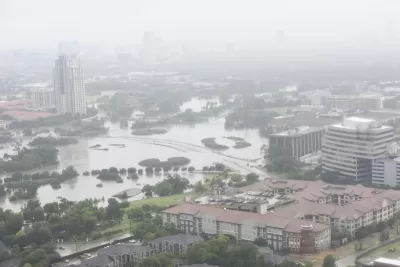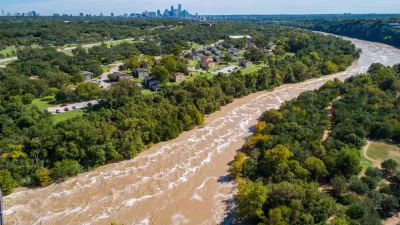Conventional wisdom is that the most resilient city is that keeps high-density housing out of flood zones. But if flooding can happen miles inland, is that still true?

After Superstorm Sandy in 2012, many people wrote about "coastal resilience"—which often meant, "let’s move people away from coasts because they might be drowned in a hurricane." (Just google “superstorm sandy” + buyout to find a few examples of this idea.) This theory makes sense if flooding only happens in flood plains near oceans and rivers.
But this week this view was proven to be, if not wrong, at least incomplete. Because of a wave of rain caused by faraway Hurricane Ida, flooding in the Northeast happened not just in places near the water, but even on higher ground. For example, during Superstorm Sandy I lived in Forest Hills, Queens. Because this neighborhood was on high ground far from any river, it suffered approximately zero effects from Sandy. By contrast, during this week’s storm, a woman drowned in her basement apartment not far from my old Forest Hills apartment. At least 13 people died from the flood in the city of New York alone, and even more died in its suburbs; right now it appears that at least some of the city fatalities were in basement apartments far from any coast.
Climate change may increase not only flooding due to coastal hurricanes, but the flooding caused by rainstorms as well. Obviously, there are many technological solutions to this problem, such as building pervious pavement to get stormwater underground instead of in our homes. But one other solution might involve a change in zoning policy that actually makes government less intrusive and costly.
It seems to me that in most American cities most of the time, small buildings are far less controversial than tall buildings. A single-story, single-family house usually attracts far less public opposition than a small apartment building, and a small apartment building will at least sometimes attract less public opposition than a high-rise. (For example, many urbanists promote so-called "Missing Middle" housing—small buildings that supply more housing than a single-family house, but that do not anger heightphobes.)
But the most controversial buildings are the safest in a flood. If you live at ground level or below ground level, you can’t easily escape from a flood, whether the flood is caused by storm surge or by rain. And if the flood happens with just a few minutes' warning (as was apparently true of some of this week's flooding), you might not be able to evacuate your residence. If you own a car, the car may be drowned by the flood waters; if you try to walk away, you might get drowned in the street.
By contrast, if (like me) you live on the fifth floor of an apartment building, the floodwaters are unlikely to reach you even if the streets above are flooded. And even if you live on a lower floor of that apartment building, you might be able to escape to a high floor in order to escape the rain—especially if the building has an elevator and the power hasn’t gone out yet.*
In other words, noncontroversial low-intensity housing is the least resilient kind of land use in a storm, while taller buildings with elevators are safer. This doesn’t mean that we need to build 90-story skyscrapers everywhere —but we should be more willing to permit buildings tall enough to survive floods (which usually means more than one or two stories).
What about development in areas near coastlines and thus vulnerable to storm surges? After Sandy, the conventional wisdom was that the less development near coasts, the better. But this argument seems somewhat less persuasive to me than it did in 2012, for two reasons. First of all, we now know that flooding is not something that just happens on the beach; if flooding can happen anywhere, "don't build anything where it floods" is no longer a practical solution. Second, even if you assume that flooding is significantly more likely near the coasts because of rising sea levels, the 2040 flood zone may look very different from the 2020 flood zone. So even if a city prohibits development in the 2020 flood zone, it may be overwhelmed by coastal flooding in the 2040 flood zone. Thus, the benefit from prohibiting development in the 2020 flood zone may be outweighed by losses in other respects (such as reduced housing supply).
So, in metro areas where the coasts are already highly developed, maybe we should be allowing safe development instead of no development. That means (among other things) buildings that are tall enough to withstand flooding, not one-story houses where occupants are unlikely to survive a flood.
I have written elsewhere that we need more housing, and in particular more compact development, for reasons unrelated to flooding (such as to increase walkability and housing supply). But the risk of flooding is one reason to favor one particular type of compact development—buildings that are high enough to stay above floodwaters.
Of course, allowing more mid- and high-rise buildings is certainly not the only way to make cities more resilient. But many otherwise more effective solutions will require spending money that cities and states might not have. By contrast, merely allowing new buildings to exist, although not as effective as preventing flooding from occurring at all, is also less costly.
*On the other hand, after the storm is over, the people who live on the tenth floor may have difficulty getting out of the building if the power has gone out. But as obnoxious as this fate is, it is better than being drowned.

Trump Administration Could Effectively End Housing Voucher Program
Federal officials are eyeing major cuts to the Section 8 program that helps millions of low-income households pay rent.

Planetizen Federal Action Tracker
A weekly monitor of how Trump’s orders and actions are impacting planners and planning in America.

Ken Jennings Launches Transit Web Series
The Jeopardy champ wants you to ride public transit.

Washington Legislature Passes Rent Increase Cap
A bill that caps rent increases at 7 percent plus inflation is headed to the governor’s desk.

From Planning to Action: How LA County Is Rethinking Climate Resilience
Chief Sustainability Officer Rita Kampalath outlines the County’s shift from planning to implementation in its climate resilience efforts, emphasizing cross-departmental coordination, updated recovery strategies, and the need for flexible funding.

New Mexico Aging Department Commits to Helping Seniors Age ‘In Place’ and ‘Autonomously’ in New Draft Plan
As New Mexico’s population of seniors continues to grow, the state’s aging department is proposing expanded initiatives to help seniors maintain their autonomy while also supporting family caregivers.
Urban Design for Planners 1: Software Tools
This six-course series explores essential urban design concepts using open source software and equips planners with the tools they need to participate fully in the urban design process.
Planning for Universal Design
Learn the tools for implementing Universal Design in planning regulations.
Heyer Gruel & Associates PA
Ada County Highway District
Institute for Housing and Urban Development Studies (IHS)
City of Grandview
Harvard GSD Executive Education
Toledo-Lucas County Plan Commissions
Salt Lake City
NYU Wagner Graduate School of Public Service





























